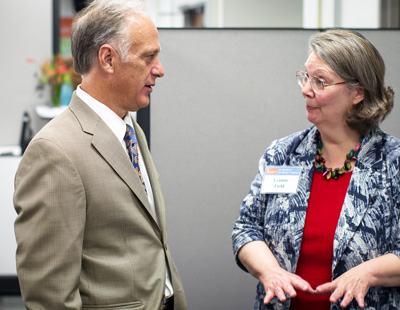Program added 63 more qualified professionals to the rapidly growing field of health IT at its graduation ceremony July 26.
 Sen. Kirk Watson and Dr. Leanne Field visit at the Longhorn Clinic during the graduation ceremony for the Health IT Certificate Program's 2012 summer class. Photo: Alex Wang.The College of Natural Sciences Health Information Technology Certificate program added 63 more qualified professionals to the rapidly growing field of health IT at its graduation ceremony July 26.
Sen. Kirk Watson and Dr. Leanne Field visit at the Longhorn Clinic during the graduation ceremony for the Health IT Certificate Program's 2012 summer class. Photo: Alex Wang.The College of Natural Sciences Health Information Technology Certificate program added 63 more qualified professionals to the rapidly growing field of health IT at its graduation ceremony July 26.
“I want to give a special note of thanks to you graduates,” said keynote speaker Texas Senator Kirk Watson. “We all know this university’s motto of ‘What Starts Here Changes the World.’ You are the ones making that change.”
With this graduating class, the health IT program has trained 273 students in the two years since the program began. It has a 91 percent rate of employment for graduates who sought employment in the field.
“Healthcare is at a crossroads and our faculty recognized the revolution taking place,” said Leanne Field, director of the program. “They collaborated with industry to create a state-of-the-art curriculum that includes knowledge and skills development, real world experience in a practicum, a research experience and professional development. We believe the program we have built has already provided a new model for health IT education, and we know that our graduates will change the world as they directly contribute to the improvement of healthcare delivery in our state and nation.”
It is projected that 50,000 new health IT professionals will be needed nationwide in the next five years and that 10,000 new jobs will be created in Texas alone in the next three years.
“When economic development takes place in the healthcare, both the economy and quality of life benefit,” Watson told the graduates. “This relationship causes your role to have that much more of an impact.”
In the nine-week certificate program, students gain hands-on experience with five different electronic health record systems and receive invaluable real-world experience during a 12-day practicum with health IT companies and healthcare organizations.
The college’s program is the first in the nation to provide students with hands-on learning with multiple electronic health record systems side-by-side in a one-of-a-kind health IT learning center, called the Longhorn Clinic. It is also the first program to develop an innovative health information exchange laboratory for students to gain experience with the interoperable movement of healthcare data in a simulated environment.
“This program has given us the knowledge, tools and connections to not just be successful today or tomorrow, but for the rest of our lives,” said Max Mathes-Redd, a graduating student.

















Comments